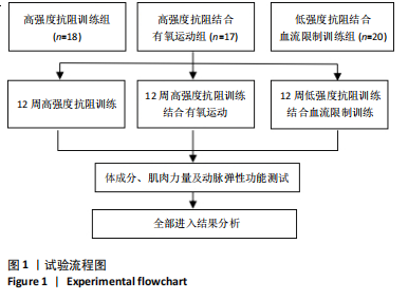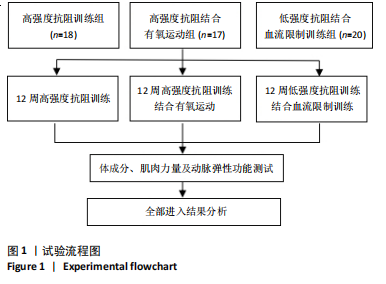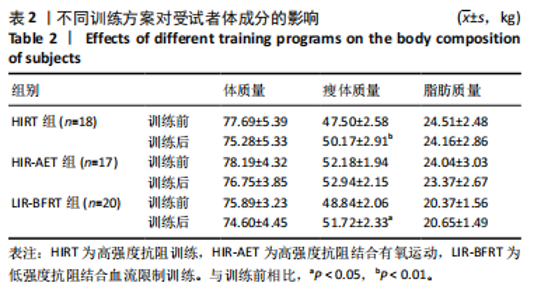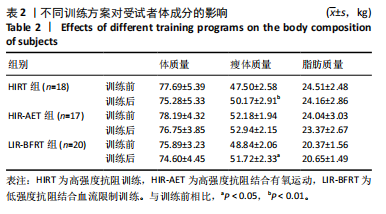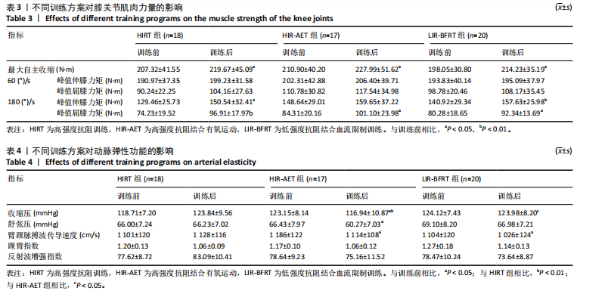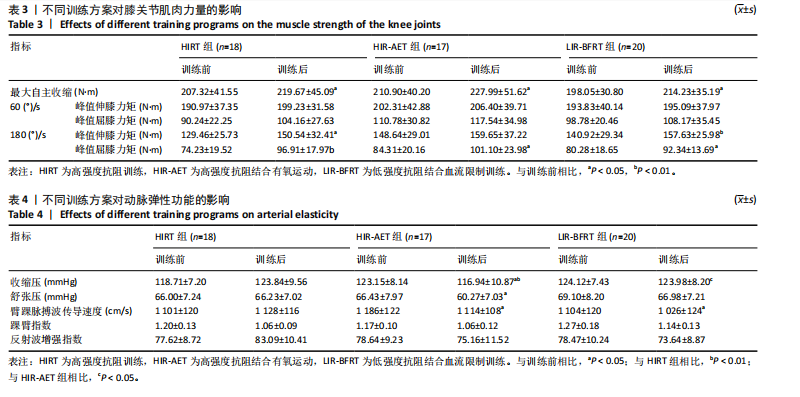Chinese Journal of Tissue Engineering Research ›› 2025, Vol. 29 ›› Issue (12): 2521-2527.doi: 10.12307/2025.395
Previous Articles Next Articles
Effects of 12 weeks of low-intensity resistance training combined with blood flow restriction training on body composition, muscle strength, and arterial elastic function in young adults
Jia Yuexin, Tian Saisai, Qi Xiaohong, Zhang Suqin
- Jiangsu Health Vocational College, Nanjing 210000, Jiangsu Province, China
-
Received:2024-04-24Accepted:2024-06-11Online:2025-04-28Published:2024-09-10 -
Contact:Zhang Suqin, Master, Associate professor, Jiangsu Health Vocational College, Nanjing 210000, Jiangsu Province, China -
About author:Jia Yuexin, Master, Lecturer, Jiangsu Health Vocational College, Nanjing 210000, Jiangsu Province, China -
Supported by:General Project of Philosophy and Social Science Research in Jiangsu Universities, No. 2023SJYB0814 (to JYX)
CLC Number:
Cite this article
Jia Yuexin, Tian Saisai, Qi Xiaohong, Zhang Suqin. Effects of 12 weeks of low-intensity resistance training combined with blood flow restriction training on body composition, muscle strength, and arterial elastic function in young adults[J]. Chinese Journal of Tissue Engineering Research, 2025, 29(12): 2521-2527.
share this article
Add to citation manager EndNote|Reference Manager|ProCite|BibTeX|RefWorks
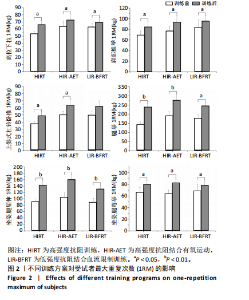
2.4 不同训练方案对1RM及膝关节肌肉力量的影响 由图2可知,与训练前相比,高强度抗阻训练、HIR-AET和LIR-BFRT后的高位下拉(P=0.023,P=0.019,P=0.044)、肩部推举(P=0.010,P=0.022,P=0.029)、上斜式杠铃卧推(P=0.031,P=0.028,P=0.067)、腿举(P=0.000,P=0.000,P=0.014)、坐姿腿屈伸(P=0.000,P=0.000,P=0.000)、坐姿腿弯举(P=0.042,P=0.034,P=0.047)1RM均出现不同程度的增加,而训练前、训练后各组间指标对比均未见显著性差异。 由表3可知,与训练前相比,高强度抗阻训练后的最大自主收缩(P=0.046)、180 (°)/s角速度下的峰值伸膝力矩(P=0.011)和屈膝力矩(P=0.000)均显著增加,HIR-AET后的最大自主收缩(P=0.034)、180 (°)/s角速度下的峰值屈膝力矩(P=0.023)均显著增加,LIR-BFRT后的最大自主收缩(P=0.039)、180 (°)/s角速度下的峰值伸膝力矩(P=0.000)和屈膝力矩(P=0.020)均显著增加,而训练前、训练后各组间指标对比均未见显著性差异。 2.5 不同训练方案对动脉弹性功能的影响 由表4可知,"
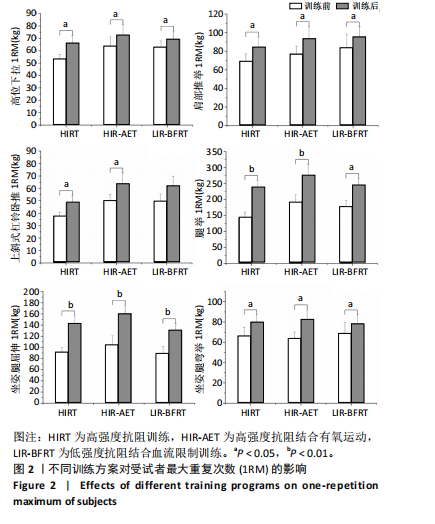
| [1] KRAEMER WJ, RATAMESS NA, FLANAGAN SD, et al. Understanding the Science of Resistance Training: An Evolutionary Perspective. Sports Med. 2017;47(12):2415-2435. [2] NYSTORIAK MA, BHATNAGAR A. Cardiovascular Effects and Benefits of Exercise. Front Cardiovasc Med. 2018;5:135. [3] VINA J, SANCHIS-GOMAR F, MARTINEZ-BELLO V, et al. Exercise acts as a drug; the pharmacological benefits of exercise. Br J Pharmacol. 2012;167(1):1-12. [4] MIYACHI M, KAWANO H, SUGAWARA J, et al. Unfavorable effects of resistance training on central arterial compliance: a randomized intervention study. Circulation. 2004;110(18):2858-2863. [5] SUGA T, OKITA K, TAKADA S, et al. Effect of multiple set on intramuscular metabolic stress during low-intensity resistance exercise with blood flow restriction. Eur J Appl Physiol. 2012;112(11):3915-3920. [6] OZAKI H, YASUDA T, OGASAWARA R, et al. Effects of high-intensity and blood flow-restricted low-intensity resistance training on carotid arterial compliance: role of blood pressure during training sessions. Eur J Appl Physiol. 2013;113(1):167-174. [7] ZOUNGAS S, ASMAR RP. Arterial stiffness and cardiovascular outcome. Clin Exp Pharmacol Physiol. 2007;34(7):647-651. [8] KAWANO H, TANAKA H, MIYACHI M. Resistance training and arterial compliance: keeping the benefits while minimizing the stiffening. J Hypertens. 2006;24(9):1753-1759. [9] GARCÍA-RODRÍGUEZ P, PECCI J, VÁZQUEZ-GONZÁLEZ S,et al. Acute and Chronic Effects of Blood Flow Restriction Training in Physically Active Patients With Anterior Cruciate Ligament Reconstruction: A Systematic Review. Sports Health. 2023;12(1):194-199. [10] JAVORSKÝ T, SAETERBAKKEN AH, ANDERSEN V, et al. Comparing low volume of blood flow restricted to high-intensity resistance training of the finger flexors to maintain climbing-specific strength and endurance: a crossover study. Front Sports Act Living. 2023;5:1256136. [11] LOWE TW, TENAN MS, SHAH K, et al. Low-load blood flow restriction reduces time-to-minimum single motor unit discharge rate. Exp Brain Res. 2023;241(11-12):2795-2805. [12] CURTY VM, MELO AB, CALDAS LC, et al. Blood flow restriction attenuates eccentric exercise-induced muscle damage without perceptual and cardiovascular overload. Clin Physiol Funct Imaging. 2018;38(3):468-476. [13] VECHIN FC, LIBARDI CA, CONCEIÇÃO MS, et al. Comparisons between low-intensity resistance training with blood flow restriction and high-intensity resistance training on quadriceps muscle mass and strength in elderly. J Strength Cond Res. 2015;29(4):1071-1076. [14] HUANG PY, JANKAEW A, LIN CF. Effects of Plyometric and Balance Training on Neuromuscular Control of Recreational Athletes with Functional Ankle Instability: A Randomized Controlled Laboratory Study. Int J Environ Res Public Health. 2021;18(10):5269. [15] DE OLIVEIRA CA, LUCIANO E, MARCONDES MC, et al. Effects of swimming training at the intensity equivalent to aerobic/anaerobic metabolic transition in alloxan diabetic rats. J Diabetes Complications. 2007;21(4):258-264. [16] AINSWORTH BE, HASKELL WL, HERRMANN SD, et al. 2011 Compendium of Physical Activities: a second update of codes and MET values. Med Sci Sports Exerc. 2011;43(8):1575-1581. [17] HARPER SA, ROBERTS LM, LAYNE AS, et al. Blood-Flow Restriction Resistance Exercise for Older Adults with Knee Osteoarthritis: A Pilot Randomized Clinical Trial. J Clin Med. 2019;8(2):265. [18] 李嘉玮,陶欣雨,姜荣荣,等.基于InBody的护生人体成分测定与分析[J].医学信息,2020,33(10):143-146. [19] COBAN O, YILDIRIM NU, YASA ME, et al Determining the number of repetitions to establish isokinetic knee evaluation protocols specific to angular velocities of 60°/second and 180°/second. J Bodyw Mov Ther. 2021;25:255-260. [20] ESGIN T, JOHNSTON N, ROWLEY K, et al. Effect of 12 weeks combined aerobic and resistance training on fitness, arterial stiffness and body composition in Indigenous Australian men and women. J Sci Med Sport. 2017; 20(3): 43-51. [21] SCHOENFELD BJ. The mechanisms of muscle hypertrophy and their application to resistance training. J Strength Cond Res. 2010;24(10): 2857-2872. [22] TAKADA S, OKITA K, SUGA T, et al. Low-intensity exercise can increase muscle mass and strength proportionally to enhanced metabolic stress under ischemic conditions. J Appl Physiol (1985). 2012;113(2):199-205. [23] SLYSZ J, STULTZ J, BURR JF. The efficacy of blood flow restricted exercise: A systematic review & meta-analysis. J Sci Med Sport. 2016;19(8):669-675. [24] FARUP J, DE PAOLI F, BJERG K, et al. Blood flow restricted and traditional resistance training performed to fatigue produce equal muscle hypertrophy. Scand J Med Sci Sports. 2015;25(6):754-763. [25] DOCHERTY D, SPORER B. A proposed model for examining the interference phenomenon between concurrent aerobic and strength training. Sports Med. 2000;30(6):385-394. [26] LUNDBERG TR, FEUERBACHER JF, SÜNKELER M, et al. The Effects of Concurrent Aerobic and Strength Training on Muscle Fiber Hypertrophy: A Systematic Review and Meta-Analysis. Sports Med. 2022;52(10):2391-2403. [27] KISHTON RJ, BARNES CE, NICHOLS AG, et al. AMPK Is Essential to Balance Glycolysis and Mitochondrial Metabolism to Control T-ALL Cell Stress and Survival. Cell Metab. 2016;23(4):649-662. [28] RICHTER EA, RUDERMAN NB. AMPK and the biochemistry of exercise: implications for human health and disease. Biochem J. 2009;418(2): 261-275. [29] WEWEGE MA, DESAI I, HONEY C, et al. The Effect of Resistance Training in Healthy Adults on Body Fat Percentage, Fat Mass and Visceral Fat: A Systematic Review and Meta-Analysis. Sports Med. 2022;52(2):287-300. [30] YASUDA T, OGASAWARA R, SAKAMAKI M, et al. Relationship between limb and trunk muscle hypertrophy following high-intensity resistance training and blood flow-restricted low-intensity resistance training. Clin Physiol Funct Imaging. 2011;31(5):347-351. [31] SILLANPÄÄ E, LAAKSONEN DE, HÄKKINEN A, et al. Body composition, fitness, and metabolic health during strength and endurance training and their combination in middle-aged and older women. Eur J Appl Physiol. 2009;106(2):285-296. [32] WILSON JM, MARIN PJ, RHEA MR, et al. Concurrent training: a meta-analysis examining interference of aerobic and resistance exercises. J Strength Cond Res. 2012;26(8):2293-2307. [33] SCOTT BR, LOENNEKE JP, SLATTERY KM, et al. Blood flow restricted exercise for athletes: A review of available evidence. J Sci Med Sport. 2016;19(5):360-367. [34] ANDERSEN LL, ANDERSEN JL, ZEBIS MK, et al. Early and late rate of force development: differential adaptive responses to resistance training? Scand J Med Sci Sports. 2010;20(1):e162-169. [35] FERRARI R, FUCHS SC, KRUEL LF, et al. Effects of Different Concurrent Resistance and Aerobic Training Frequencies on Muscle Power and Muscle Quality in Trained Elderly Men: A Randomized Clinical Trial. Aging Dis. 2016;7(6):697-704. [36] FAHS CA, ROSSOW LM, LOENNEKE JP, et al. Effect of different types of lower body resistance training on arterial compliance and calf blood flow. Clin Physiol Funct Imaging. 2012;32(1):45-51. [37] 刘严,齐丽彤,马为,等.桡动脉反射波增强指数与其他动脉硬化指标的关系[J].北京大学学报(医学版),2013,45(6):916-922. [38] OTSUKI T, NAMATAME H, YOSHIKAWA T, et al. Combined aerobic and low-intensity resistance exercise training increases basal nitric oxide production and decreases arterial stiffness in healthy older adults. J Clin Biochem Nutr. 2020;66(1):62-66. [39] RAKOBOWCHUK M, MCGOWAN CL, DE GROOT PC, et al. Effect of whole body resistance training on arterial compliance in young men. Exp Physiol. 2005;90(4):645-651. [40] LITWIN M, OBRYCKI Ł, NIEMIRSKA A, et al. Central systolic blood pressure and central pulse pressure predict left ventricular hypertrophy in hypertensive children. Pediatr Nephrol. 2019;34(4):703-712. |
| [1] | Zhang Zixian, Xu Youliang, Wu Shaokui, Wang Xiangying. Effects of blood flow restriction training combined with resistance training on muscle indicators in college athletes: a meta-analysis [J]. Chinese Journal of Tissue Engineering Research, 2025, 29(8): 1705-1713. |
| [2] | Wang Juan, Wang Guanglan, Zuo Huiwu. Efficacy of exercise therapy in the treatment of anterior cruciate ligament reconstruction patients: #br# a network meta-analysis #br# [J]. Chinese Journal of Tissue Engineering Research, 2025, 29(8): 1714-1726. |
| [3] | Zhao Xiaoxuan, Liu Shuaiyi, Li Qi, Xing Zheng, Li Qingwen, Chu Xiaolei. Different exercise modalities promote functional recovery after peripheral nerve injury [J]. Chinese Journal of Tissue Engineering Research, 2025, 29(6): 1248-1256. |
| [4] | Ji Long, Chen Ziyang, , Jin Pan, Kong Xiangkui, Pu Rui, . Lipophagy, exercise intervention and prevention and treatment of nonalcoholic fatty liver disease [J]. Chinese Journal of Tissue Engineering Research, 2025, 29(35): 7611-7619. |
| [5] | Liu Chenchen, Liu Ruize, Bao Mengmeng, Fang Li, Cao Liquan, Wu Jiangbo. Blood flow restriction training intervention in the elderly with sarcopenic obesity [J]. Chinese Journal of Tissue Engineering Research, 2025, 29(32): 6963-6970. |
| [6] | Wang Jiaqian, , Jiang Changjun, Peng Yi, Ma Mi, Li Junhan. Study on the role of aerobic exercise in regulating the CNPY2-mediated AKT/GSK3β pathway for improving non-alcoholic fatty liver [J]. Chinese Journal of Tissue Engineering Research, 2025, 29(30): 6441-6448. |
| [7] | Jiang Siqi, Huang Huanhuan, Yu Xinyu, Peng Ying, Zhou Wei, Zhao Qinghua. Meta-analysis of dose-effect of exercise on improving muscle health in community-dwelling older adults with sarcopenia [J]. Chinese Journal of Tissue Engineering Research, 2025, 29(29): 6295-6304. |
| [8] | Ding Yuan, Gong Jianbao, Zhang Jie, Qiao Yuan, Xu Wenlong. Characteristic analysis of isometric muscle strength of knee joint in patients after unicompartmental knee arthroplasty [J]. Chinese Journal of Tissue Engineering Research, 2025, 29(27): 5833-5838. |
| [9] | He Ningjuan, Li Li, Wang Su, Yang Jianshe, Lei Siyun, Wang Yang. Effects of aerobic or resistance exercise on hippocampal ras/Drebrin dendritic spine plasticity in a mouse model of Alzheimer’s disease [J]. Chinese Journal of Tissue Engineering Research, 2025, 29(26): 5528-5535. |
| [10] | Wang Xia, Xue Boshi, Yang Chen, Zhou Zhipeng, Zheng Liangliang. Influence of neuromuscular function on the risk of biomechanical injury in landing manoeuvres in patients undergoing anterior cruciate ligament reconstruction [J]. Chinese Journal of Tissue Engineering Research, 2025, 29(26): 5556-5562. |
| [11] | Zhu Tianrui, Shi Jipeng, Sun Jiahe, Wang Luyi, Zhang Chen, Xu Hongqi, Quan Helong. Effectiveness of different exercise regimens to reduce fall risks in older adults: a Meta-analysis [J]. Chinese Journal of Tissue Engineering Research, 2025, 29(26): 5662-5672. |
| [12] | Zhao Peng, Wang Congcong, Wang Chenyu. Effect of aerobic exercise on mobilization and function of endothelial progenitor cells in patients with myocardial infarction [J]. Chinese Journal of Tissue Engineering Research, 2025, 29(23): 4947-4955. |
| [13] | Hu Shujuan, Cheng Ping, Zhang Xiao, Ding Yiting, Liu Xuan, Pu Rui, Wang Xianwang. Effects of different exercise interventions on carboxylesterase 1 and inflammatory factors in skeletal muscle of type 2 diabetic rats [J]. Chinese Journal of Tissue Engineering Research, 2025, 29(2): 269-278. |
| [14] | Peng Yong, Hu Jiangping, Zhu Huan. Effects of low-load blood flow restriction exercise and high-intensity resistance exercise on the thigh microcirculation function of athletic young men [J]. Chinese Journal of Tissue Engineering Research, 2025, 29(2): 393-401. |
| [15] | Zhao Yuhan, Li Yamei, Yan Shifang, Jiang Huabei. Immediate effects of different stretching methods on knee joint muscle strength and vertical jump performance of healthy adults [J]. Chinese Journal of Tissue Engineering Research, 2025, 29(18): 3784-3790. |
| Viewed | ||||||
|
Full text |
|
|||||
|
Abstract |
|
|||||
